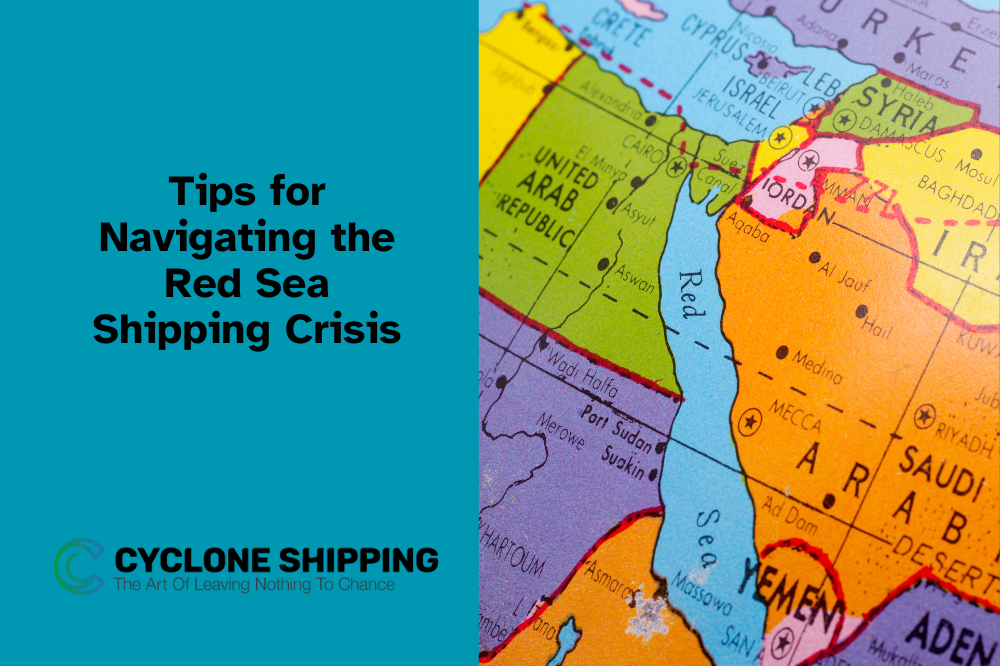Throughout this year, the Red Sea has become an increasingly precarious zone for global shipping. With rising geopolitical instability and direct threats to vessel safety, businesses that rely on timely international freight are witnessing new risks and shipping challenges. For those in industries where timing is critical due to shipping perishable items, these issues can be even more disruptive. Let’s get a handle on the Red Sea shipping crisis so you can better maneuver these challenging times.
Understanding the Red Sea Crisis
The Red Sea corridor is an essential route for global shipping as a link between Europe and Asia. About 40% of trade between Asia and Europe passes through the region, with the key chokepoints of the Bab el-Mandeb Strait and Suez Canal providing fast routes for vessels. However, recent escalations in regional conflicts, particularly with insurgent threats in Yemen, have put the area at significant risk for shipping disruptions. NATO has recently expressed concerns over security in the region, advising caution due to increased attacks on commercial ships in the past year.
Because of the violence and instability, shipping companies are looking at higher insurance premiums and risks. And that means higher freight costs as well as potential shipping delays. Major shipping firms, including Maersk, have already rerouted vessels around the Cape of Good Hope—a detour that increases fuel consumption nearly 30% and add weeks to travel time. For businesses needing a faster solution, this means not only higher costs but also potential disruptions to supply chains.
Economic Effects to the Supply Chain
It’s hard to overstate the financial impact of the Red Sea shipping crisis. As we’ve seen with other delays and port congestion, which have required cargo ships to seek alternate routes, costs quickly mount. Shipping rates on longer routes have spiked as much as 40%, while insurance premiums are climbing up to 20% as a result of the added risks and expenses. These delays and rising costs can jeopardize business, especially smaller ones and those that rely on this vital passageway.
In addition to notable cost increases, delays have wider-reaching effects. The overall efficiency of supply chains suffers as inventory positioning becomes increasingly complex. Businesses that rely on just-in-time delivery must now consider building buffer stocks to provide uninterrupted supply, which can be a further strain on budgets. According to recent studies, businesses are finding it necessary to revisit inventory practices and plan for potential delays, which may have ripple effects in supply chains across multiple sectors.
Engage a Freight Forwarder as Your Strategic Partner
When supply chains are affected, it’s hard for businesses to know how to navigate new routes and challenges. That’s why choosing to partner with a freight forwarder who understands the nuances of the global shipping network, including this recent Red Sea crisis, is crucial. At Cyclone Shipping, we are experts in managing risks associated with transporting goods through high-risk regions. If you are reviewing which freight forwarder to choose, ensure your choice offers the following:
1. Proactive Route Optimization
Freight forwarders leverage advanced logistics technology to monitor and assess optimal routes, offering clients the best options based on cost, time, and safety. Given the instability in the Red Sea, your freight partner should be able to analyze real-time data to determine if alternative routes (such as around the Cape of Good Hope) are beneficial or if certain windows for Red Sea transits are safer and more economical.
2. Risk-Mitigation Expertise
Determine if your freight forwarder of choice has extensive experience in high-risk shipping zones and is well-versed in managing insurance and security measures to protect shipments. By working with insurance partners, freight specialists ensure that your goods are adequately covered, even with elevated premiums, helping you minimize unforeseen expenses.
3. Sustainability Commitment
The increased use of the Cape of Good Hope route due to the Red Sea shipping crisis has resulted in higher fuel consumption and carbon emissions. Environmentally conscious freight forwarders should strive to offset these global impacts through sustainable practices, including partnering with shipping lines committed to reducing their carbon footprints through advanced fuel management and emission-reduction technologies.
4. Industry-Specific Solutions for Perishable Goods
For businesses transporting perishable goods, timing is crucial. You need to partner with a freight forwarder who has experience in perishable goods logistics and an understanding of the importance of minimizing transit time and preventing delays.
Trust Cyclone Shipping to Navigate Uncertain Waters with Confidence
The Red Sea shipping crisis has once again illustrated the need for resilient, flexible logistics solutions. With the current situation likely to continue or even escalate, businesses that depend on fast, reliable global shipping must carefully assess their logistics strategies. By choosing Cyclone Shipping, you gain a partner that combines deep industry knowledge with strategic foresight, ensuring that your goods navigate the Red Sea and other routes with minimal disruptions.
While global conditions are beyond any single company’s control, Cyclone Shipping’s agility and proactive approach empower our clients to face these challenges head on. Our team of experts is here to support your business, guiding your shipments through complex and volatile regions with professionalism and care. Learn more here.




